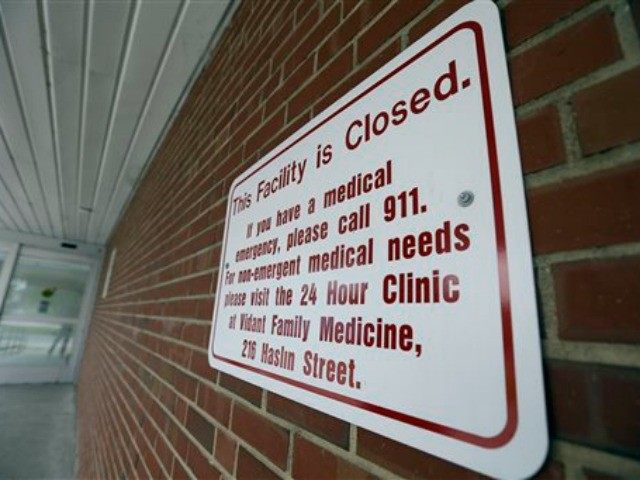A new report released by the Association of American Medical Colleges (AAMC) projects that by 2025 there will be between 61,700 and 94,700 fewer doctors in the United States.
Reasons for the shortfall, the report says, include increased demand due to Obamacare’s Medicaid expansion and the fact that Americans are living longer, while the supply of physicians is being cut due to aging and retirement, as well as potential doctors’ reassessment of careers in medicine in light of the high costs of earning a medical degree and medical malpractice insurance.
As the United States observes the recent sixth anniversary of Obamacare, Forbes notes:
This month, CBO estimates 68 million will be dependent on the program this year through 2019 – an increase of almost one third in the welfare caseload.
Many observers have recognized that Obamacare is a welfare program camouflaged as a reformed health insurance marketplace. CBO’s new estimate that Obamacare will actually leave five million more uninsured than initially estimated suggests even that camouflage is beginning to fail.
Forbes additionally reports on the fact that illegal immigrants are also obtaining healthcare under Obamacare.
Though Obamacare “contains an explicit prohibition against providing federally-subsidized coverage to immigrants who cannot prove they are here legally,” Chris Conover writes, “no honest person can deny that because of Obamacare, more taxpayer resources at the state and local level are being spent on health care of illegal immigrants than would have been spent otherwise.”
AAMC addresses a scenario in which the demand for physician services grows due to Obamacare’s Medicaid expansion. To control for costs, Accountable Care Organizations (ACOs) have become the trend under Obamacare, serving a similar function as managed care organizations of the past.
The report notes:
Well-managed ACOs are often capable of accepting the associated risk and managing care under bundled payment systems in part because they may be well suited to manage patient flows and reengineer care delivery systems to improve efficiency. Yet a more fully developed bundled payment system will take time to develop and diffuse. How that occurs will have implications for care and for the delivery system workforce more broadly, so continued work to assess the impact of ACOs is crucial…
The effect of ACA-related expansion in medical insurance coverage had already started by 2014, but between 2014 and 2025, the projected effect is additional demand of about 10,600 physicians, of which 7,600 is specific to non-primary care specialties.
Some physicians, however, have already observed the toll of federalized medicine on physicians’ independence to treat their patients.
In June of last year, Dr. Richard Amerling, associate professor of clinical medicine at Beth Israel Medical Center in New York City, and president of the Association of American Physicians and Surgeons (AAPS), told Breitbart News the GOP-led Congress’ reauthorization of the Medicare Access and Children’s Insurance Program (CHIP) “cemented into place the centralized control of medical practice through ACOs, bundling, and other forms of ‘pay-for-performance.’”
Dr. Gerard Gianoli, a specialist in Neuro-Otology and Skull Base Surgery at The Ear and Balance Institute in Covington, Louisiana, also told Breitbart News the ACA was supposed to remedy the problems of cost and access regarding healthcare.
“Unfortunately, not only has the ACA not fixed these problems, but it has actually made them worse,” he said. “With all medical care running through insurance, this will continue to increase costs — as noted by requests for 25-50 percent premium increases by the private insurance companies.”
“Access to healthcare is actually reduced by two mechanisms — narrowed networks and higher deductibles — both made worse by the ACA,” he said. “The only solution to this is a president and Congress that will repeal the ACA and restore a true free market to medical care as we have seen in Refractive Eye Surgery, Cosmetic Surgery and Third Party Free Medical Practices. All three of these have reduced cost while increasing quality, unlike the current system.”
The AAMC report finds that – as Americans age and live longer – the demand for physicians will grow overall by between 11 and 17 percent through 2025, while the actual number of physicians will only increase by 4-12 percent.
The number of physicians who specialize in several larger surgical fields, such as ophthalmology and urology, is projected to decline by 2025. The demand for these surgical specialists, however, will rise significantly, says the report. A projected shortfall of between 25,200 and 33,200 total surgeons is expected within the next decade.
For all specialty categories, physician retirement decisions are projected to have the greatest impact on the supply of doctors. More than one-third of doctors currently practicing in a specialty area will be 65 or older within the next decade.
“These updated projections confirm that the physician shortage is real, it’s significant, and the nation must begin to train more doctors now if patients are going to be able to receive the care they need when they need it in the near future,” AAMC president and CEO Darrell Kirch said in a statement, reports Business Insider. Consequently, AAMC is calling for more federal intervention in new physician training.

COMMENTS
Please let us know if you're having issues with commenting.